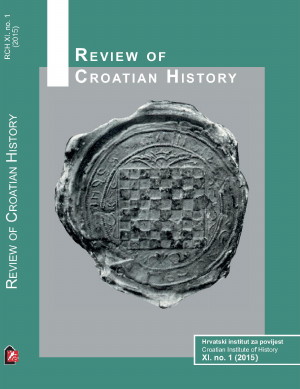DIE EINZELHEITEN UND UNTERSCHIEDE ZWISCHEN DEN WAHLEN IN SLOWENIEN UND KROATIEN IN DEN JAHREN 1920–1927
Details and differences in elections in Slovenia and Croatia from 1920 to 1927
Author(s): Bojan Balkovec, Ivana Šubic KovačevićSubject(s): History, Political history, Recent History (1900 till today), Electoral systems, Pre-WW I & WW I (1900 -1919), Interwar Period (1920 - 1939)
Published by: Hrvatski institut za povijest
Keywords: The Kingdom of Serbs; Croats and Slovenes; elections; political parties; Slovenia; Croatia; 1920-1927
Summary/Abstract: The article presents the basic characteristics of electoral legislation in the Kingdom of Serbs, Croats and Slovenes from 1920 and 1922. The electoral legislation stipulated the boundaries of the constituencies based on regional courts in Slovenia and counties in Civil Croatia. Zagreb and Ljubljana, as the capital cities, were separate constituencies. Besides Ljubljana, Slovenia had two other constituencies, while in addition to Zagreb, Croatia had eight constituencies. The constituencies in Slovenia and Civil Croatia were much larger than those in Serbia. The political situation in both Croatia and Slovenia was similar with regard to elections, as it was apparent that a single party was dominant. In Croatia this was the Croatian Peasant Party (HSS) led by Stjepan Radić, while in Slovenia this was the Slovenian People’s Party under the leadership of Anton Korošec. Both parties advocated a less harsh/more moderate centralization, meaning a system that would at least acknowledge the features of individual provinces to some degree. A vital element that exerted an impact on the final election results in Croatia and Slovenia was ethnicity. In Croatia, this entailed the Serbs, while in Slovenia it entailed the Germans. Yugoslav parliamentarism managed to survive in the 1920s despite the system’s considerable instability, in which King Aleksandar often intervened, whose constitutionally and legally defined influence was not negligible. Political conflicts led to an assassination on the floor of parliament in Belgrade, which led King Aleksandar to take matters into his own hands on 6 January 1929, when he dissolved parliament and instituted a dictatorship. Parliamentary life was restored in the autumn of 1931. The similarities between the initial activity of the two most powerful parties in Croatia and Slovenia had disappeared entirely later in the 1930s.
Journal: Review of Croatian History
- Issue Year: XI/2015
- Issue No: 1
- Page Range: 47-81
- Page Count: 35
- Language: German

